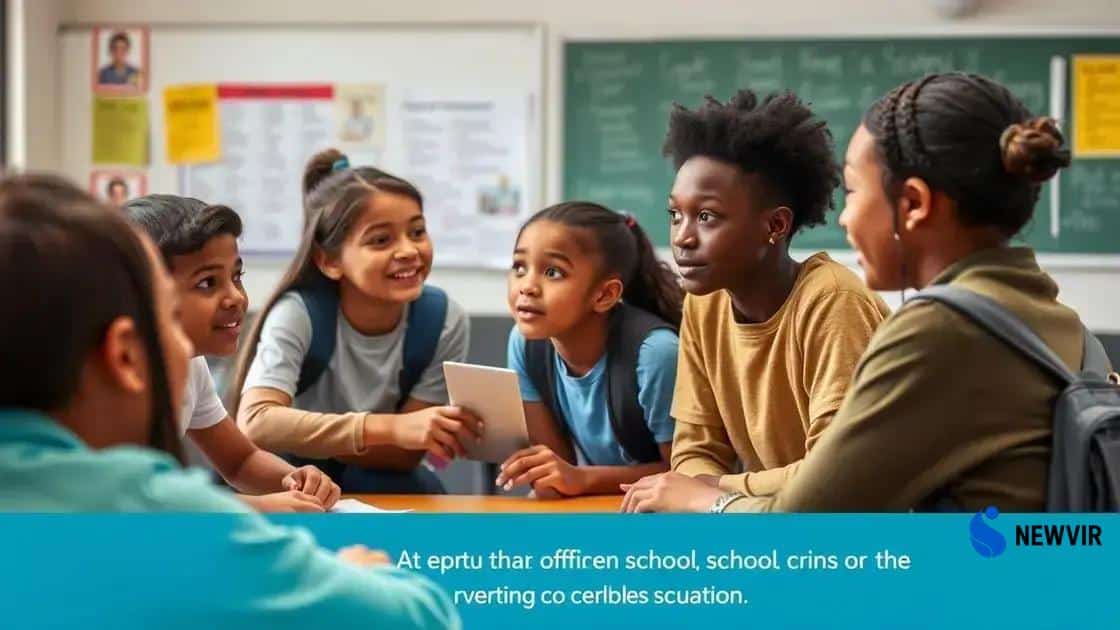Evolving strategies in school choice policy frameworks

Evolving strategies in school choice policy frameworks enhance educational opportunities by allowing families to select schools that best fit their children’s needs, promoting equity and innovative learning environments.
Evolving strategies in school choice policy frameworks offer insights into how educational options can create diverse opportunities for students. Have you considered how these changes might impact your community?
Understanding school choice policies
Understanding school choice policies is essential for parents, educators, and policymakers. These policies affect how families select schools that best fit their children’s needs. By learning about these frameworks, we can better navigate the education landscape.
What are school choice policies?
School choice policies give families options beyond the traditional public school system. They include charter schools, magnets, and voucher programs. Each of these options has unique advantages and challenges.
Key components of school choice policies
Several key components shape these policies, including:
- Funding mechanisms: Different funding approaches can impact the accessibility of school choice.
- Admission criteria: Policies often dictate how students can apply and be accepted into schools.
- Accountability standards: Schools may face varying levels of accountability based on their funding and operational models.
- Community involvement: Engaging parents and local communities is crucial in developing effective school choice policies.
As we’ve seen, school choice can empower families to seek the most suitable educational opportunities for their children. However, it also raises questions about equity and access. Families need to be informed about their options and the implications those choices can have on their children’s education.
Furthermore, understanding the impact of school choice on overall student success is vital. Research indicates that school choice can lead to better academic outcomes in some cases. The key lies in ensuring that all families have equal access to information and opportunities.
As we navigate this evolving landscape, keeping an open dialogue about school choice is important. By sharing knowledge and experiences, communities can work towards a more equitable education system.
Key trends in school choice strategies
Key trends in school choice strategies are reshaping the educational landscape. With various options available, families are more empowered than ever to choose what best fits their children’s needs. Understanding these trends is crucial for navigating education today.
Rise of charter schools
Charter schools have gained popularity as an alternative to traditional public schools. They often have more flexibility in curriculum and teaching methods. This can lead to innovative approaches to education that meet diverse student needs.
Increased focus on equity
There is a growing emphasis on ensuring that school choice models provide equitable access for all families. Policymakers are working to address barriers that low-income families face when selecting schools, such as transportation and information access.
- Policy reforms: New policies aim to support under-resourced communities.
- Affordability: Vouchers and scholarships can help families afford their preferred schools.
- Community partnerships: Schools are collaborating with local organizations to improve outreach.
The integration of technology in education is also a significant trend. Online and blended learning options expand the choices available to students. These methods can enhance learning experiences by providing more personalized education pathways.
Furthermore, parental involvement is a critical factor influencing school choice. Engaged parents can advocate for better options within their local communities. When families are informed and actively participate, it contributes to the success of school choice strategies.
Ultimately, the evolving landscape of school choice continues to transform how education is delivered and accessed. Keeping an eye on these trends helps ensure that students receive the quality education they deserve.
Impact of school choice on student outcomes

The impact of school choice on student outcomes is a critical aspect that affects families and communities. As educational options expand, understanding how these choices influence student success becomes vital.
Academic performance
Research shows that school choice can lead to improved academic performance for some students. Families often select schools based on their educational needs, resulting in better engagement and achievement.
Social skills development
Students in diverse school environments have opportunities to enhance their social skills. Exposure to different cultures and backgrounds helps children learn to interact with various peers.
- Improved communication: Engaging with a diverse student body fosters better communication skills.
- Collaboration: Group projects in diverse settings teach teamwork and cooperation.
- Increased resilience: Navigating different social dynamics builds emotional strength.
Moreover, school choice can impact students’ mental well-being. When families have the freedom to choose schools that align with their values and expectations, students often feel more supported and understood.
Access to specialized programs is another benefit of school choice. Many schools offer programs tailored to specific talents or interests. This allows students to pursue their passions, whether in the arts, sciences, or sports.Choosing the right school can significantly affect a student’s future opportunities, including college readiness and career prospects.
It’s essential to note that not all students experience positive outcomes from school choice. Challenges such as transportation and information gaps can hinder some families from accessing preferred schools. However, successful school choice can create pathways for students to thrive academically and socially.
Community involvement in school choice
Community involvement in school choice plays a vital role in shaping educational opportunities. When parents, local organizations, and schools collaborate, they create a robust support system for students. This engagement helps to enhance the overall educational experience.
The role of parents
Parents are key players in the school choice process. They not only select schools for their children but also advocate for their needs. By participating in school boards and community meetings, parents can influence decisions that affect education.
Partnerships with local organizations
Schools partnering with local organizations can provide additional support to families. These partnerships can include:
- Tutoring programs: Local nonprofits may offer after-school assistance to students.
- Workshops: Parents can learn about navigating school choice options through educational sessions.
- Resource sharing: Schools can share resources with community organizations to better support student needs.
When communities come together, it creates a network of resources that benefits everyone. Local businesses and organizations can also contribute by sponsoring events and providing internships for students. This involvement exposes students to real-world experiences and helps build important skills.
Engaging families in decision-making processes fosters a sense of ownership in schools. When community members feel invested, they are more likely to support initiatives that benefit education. Incorporating feedback from families can lead to better alignment between schools and community needs.
Moreover, promoting active participation in school choice discussions encourages transparency. By keeping communication open, communities can address concerns and highlight successes. Overall, strong community involvement is essential for effective school choice policies.
Future of school choice policies
The future of school choice policies presents exciting opportunities for families and students. As educational needs evolve, so too will the ways we think about school choice. New approaches are emerging that prioritize flexibility and equity.
Innovative policy approaches
One trend shaping the future is the introduction of more flexible schooling options. This includes the rise of online education and hybrid learning models. These options allow students to learn at their own pace and access a broader range of resources.
Funding challenges and solutions
Funding remains a critical consideration in school choice policies. As demands grow, policymakers are exploring new funding models. Some ideas include:
- Weighted funding: Allocating resources based on individual student needs.
- Public-private partnerships: Collaborating with businesses to support educational initiatives.
- Increased vouchers: Expanding voucher programs to give more families access to alternative schooling.
Equity remains a focus as well. Ensuring all families have equal access to quality education is vital. Policymakers are investigating strategies to close gaps in resources and support for underserved communities.
The role of technology will also continue to grow. Emerging tools can enhance educational experiences, making learning more interactive and personalized. Innovations in artificial intelligence may assist educators in tailoring lessons to student strengths.
Furthermore, community involvement will drive the success of school choice initiatives. Engaged families and local organizations contribute to better decision-making processes. As these groups collaborate, they can influence the direction of policies to reflect community needs.
Lastly, as public opinion evolves around education, policymakers will likely face increased demands for transparency. Families want to understand how decisions are made and what impacts they have on their children’s education.
FAQ – Frequently Asked Questions about School Choice Policies
What are school choice policies?
School choice policies allow families to select educational options beyond traditional public schools, such as charter schools, magnets, and voucher programs.
How do school choice policies affect student outcomes?
These policies can improve academic performance and social skills, providing students with more opportunities to succeed in diverse environments.
Why is community involvement important in school choice?
Community involvement fosters collaboration and ensures that schools reflect local needs, creating a supportive network that benefits students and families.
What is the future of school choice policies?
The future includes innovative approaches focusing on equity, technology integration, and flexible learning options to better serve all students.






